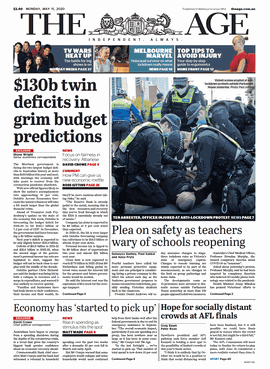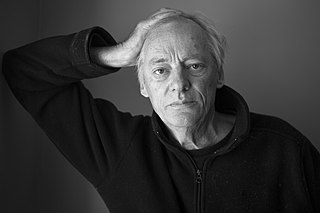Related Research Articles

The Age is a daily newspaper in Melbourne, Australia, that has been published since 1854. Owned and published by Nine Entertainment, The Age primarily serves Victoria, but copies also sell in Tasmania, the Australian Capital Territory and border regions of South Australia and southern New South Wales. It is delivered both in print and digital formats. The newspaper shares some articles with its sister newspaper the Sydney Morning Herald.
Photography Studies College, commonly abbreviated to PSC, is a privately owned independent tertiary photography college established in 1973, located in Melbourne, Victoria, Australia.
David Moore was an Australian photojournalist, historian of Australian photography, and initiator of the Australian Centre for Photography.
Mark Ray is a former Australian first-class cricket player.

Carol Jerrems was an Australian photographer/filmmaker whose work emerged just as her medium was beginning to regain the acceptance as an art form that it had in the Pictorial era, and in which she newly synthesizes complicity performed, documentary and autobiographical image-making of the human subject, as exemplified in her Vale Street.
Jack Atley is an Australian photographer.
Reynolds Mark Ellis was an Australian social and social documentary photographer. He also worked, at various stages of his life, as an advertising copywriter, seaman, lecturer, television presenter and founder of Brummels Gallery of Photography, Australia's first dedicated photography gallery, where he established both a photographic studio and an agency dedicated to his work, published 17 photographic books, and held numerous exhibitions in Australia and overseas.
Robert Rooney (1937–2017) was an artist and art critic from Melbourne, Australia, and a leading figure in Australian Conceptual art.

Patrick Bingham-Hall is an architectural photographer. He is also an architectural writer and editor, and owner of Pesaro Publishing.
Mark Strizic was a 20th-century German-born Australian photographer, teacher of photography, and artist. Best known for his architectural and industrial photography, he was also a portraitist of significant Australians, and fine art photographer and painter known for his multimedia mural work.

John Chester Cato was an Australian photographer and teacher. Cato started his career as a commercial photographer and later moved towards fine-art photography and education. Cato spent most of his life in Melbourne, Australia.
Laurence Craddock Le Guay, was an Australian fashion photographer.
Jesse Marlow (1978) is an Australian street photographer, editorial and commercial photographer who lives and works in Melbourne.

The Australian Centre for Photography (ACP) was a not-for-profit photography gallery in Darlinghurst, Sydney, Australia that was established in 1973 and which also provided part-time courses and community programs.
Andrew Quilty is an Australian photojournalist based in Afghanistan.

Andrew Chapman OAM, is an Australian photojournalist.
Philip Quirk is an Australian photographer, photojournalist and educationist, known for his specialist imagery of landscape, geographic and documentary photography, and as a founding member of the Wildlight agency.
Helmut Gritscher was an Austrian-born skier, ski instructor and photographer who worked in Australia 1961–70.
The Rest of Australia cricket team was a domestic first-class cricket team in Australia that played intermittently between 1872/73 and 1939/40.
Rozalind Drummond is a photographic artist and an early exponent of postmodernism in Australia.
References
- 1 2 3 4 Whelan, Kathleen (2014), Photography of the Age : newspaper photography in Australia, from glass plate negatives to digital, Brolga Publishing, ISBN 978-1-922175-66-3
- ↑ Rosslyn Beeby, 'Creative tactics introduce dull note to blockade', The Age, 5 Jan 1983, p. 5.
- ↑ The Sydney Morning Herald, 5 Dec 1980, p. 8.
- ↑ The Age, 7 Mar 1981, p. 3.
- ↑ 'Photography prizes', The Age, 16 Nov 1982, p. 3.
- ↑ 'Luckless, helpless, and nearly friendless', The Age , August 17, 1973, p. 5.
- ↑ Barbara Hooks, 'Car crash children need funds urgently', The Age, 5 Aug 1975, p. 10.
- ↑ 'Witness says he saw newspapers removed', The Age, 16 Sep 1981, p. 14.
- ↑ 'Press photographers cover the media gap', The Age, 17 Dec 1986, p. 27.
- ↑ Nikki Barrowclough, "Lady Bountiful", The Sydney Morning Herald, 24 Mar 1990
- ↑ Sue Neales, "Going with the flow", The Age, 29 Dec 1994, p. 55.
- ↑ Megan Backhouse, "Life on the line", The Age, 21 Jan 1994, p. 29.
- ↑ David M. Walker, "Her Majesty's apartments, Pentridge", The Age, 16 Jan 1997, p. 25.
- ↑ Geoff Stong, "Trouble in paradise, The Age, February 6, 1999
- ↑ "Curse that brought victory, The Age, 18 Jun 1996, p. 58.
- ↑ 'Three snap awards', The Age, 9 Feb 1980, p. 16.
- ↑ 'The snake bite had a happy ending' The Sydney Morning Herald, 9 Feb 1980, p. 3.
- ↑ 'Pictorial prize to Age man', The Age, 6 Feb 1982, p. 3.
- ↑ Louise Carbines, 'Age photographer scoops pool wit Cash shots', The Age, 3 Mar 1984, p. 3.
- ↑ The Age, 1 Jan 1981, p. 7.
- ↑ 'It's not just his popularity that's thinning', The Age, 2 Feb 1992, p. 16.
- ↑ Fiona Capp, "Romantics on the road", The Age, 6 Nov 1993, p. 170.
- ↑ The Age, 14 Feb 1975, p. 24.
- ↑ Brian Courtis, 'Alchemy and the arts', The Age, 8 Apr 1999, p. 62.
- ↑ Larry Shwartz, 'Selling the soul of Jimmy Barnes', The Age, 10 Nov 1991, p. 22.
- ↑ Dennis, Anthony, 1963- (1989). Ticket to ride : a rail journey around Australia. Rayner, Michael, 1951-. New York: Prentice Hall Press. ISBN 0-13-921198-5. OCLC 21558073.
{{cite book}}: CS1 maint: multiple names: authors list (link) CS1 maint: numeric names: authors list (link) - ↑ 'A rail chance to travel', The Sydney Morning Herald, 29 Dec 1988, p. 11.
- ↑ The Philadelphia Inquirer, May 27, 1990, p. 128.
- ↑ The Times (Louisiana), May 27, 1990, p. 108.
- ↑ Journal and Courier, Lafayette, Indiana, May 27, 1990, p. 46.
- ↑ Florida Today, June 3, 1990, p. 53.
- ↑ The Orlando Sentinel, July 8, 1990, p. 130.
- ↑ Coward, Mike. (1991). Caribbean odyssey : Australia and cricket in the West Indies. Rayner, Michael. Sydney: Simon & Schuster. ISBN 0-7318-0232-2. OCLC 30510913.
- ↑ Mark Ray, 'Remarks set to ruffle feathers: Caribbean exposed', The Age, p. 51.
- ↑ Coward, Mike. (1994). Australia vs the new South Africa : cricket contact renewed. East Roseville, N.S.W.: Simon & Schuster Australia. ISBN 0-7318-0436-8. OCLC 38356771.
- ↑ Rayner, Michael; Graus, Philip (1990). Sydney since the Opera House: an architectural walking guide. [Sydney?], New South Wales. ISBN 1-86318-011-7. OCLC 26827068.
{{cite book}}: CS1 maint: location missing publisher (link) - ↑ Rayner, Michael; Age (Melbourne, Vic.); John Fairfax & Sons (1983), [Bob Hawke, 1983] , retrieved 30 December 2020
- ↑ Rayner, M., & Sunday Observer. (1988). Tracey Curro / Michael Rayner.